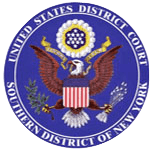United States v. Morgan (1953)
| United States v. Morgan | |
|---|---|
 | |
| United States District Court for the Southern District of New York | |
| Full case name | United States v. Morgan et al. |
| Date decided | October 14, 1953 |
| Citations | 118 F. Supp. 621 (S.D.N.Y. 1953) |
| Judge sitting | Harold Medina |
| Plaintiff(s) | United States of America |
| Defendant(s) | 17 defendants (see list in article) |
| Keywords | |
| Investment Bankers Case | |
United States v. Morgan, 118 F. Supp. 621 (S.D.N.Y. 1953), more commonly referred to as the Investment Bankers Case was a multi-year antitrust case against brought by the United States Justice Department against seventeen of the most prominent Wall Street investment banking firms, known as the Wall Street Seventeen.[1][2][3]
Facts
The Justice Department filed suit against the firms in 1947 claimed that the leading investment banking firms had combined, conspired and agreed, in violation of the Sherman Antitrust Act, to control and monopolize the U.S. Securities markets.
The 17 Wall Street firms named as defendants in the case, later known as the "Wall Street Seventeen" were as follows:[1][4]
- Morgan Stanley & Co.
- Kidder Peabody
- Goldman Sachs
- White Weld & Co.
- Dillon Read & Co.
- Drexel & Co.
- First Boston Corporation
- Smith Barney & Co.
- Kuhn, Loeb & Co.
- Lehman Brothers
- Blyth & Co.
- Eastman Dillon & Co.[5]
- Harriman Ripley
- Stone & Webster Securities Corp.
- Harris, Hall & Co.
- Glore, Forgan & Co.
- Union Securities Corp.
Excluded from the case were a number of prominent Wall Street firms including Bache & Co., Halsey Stuart & Co., Merrill Lynch, Pierce, Fenner & Beane and Salomon Brothers & Hutzler among others.
Judgment
The case, which was brought to trial in the Southern District of New York in 1952 was presided over by Harold Medina. In October 1953, after a year-long trial, Medina found in favor of the investment banking firms.
See also
References
- 1 2 A financial history of the United States Vol. 3. M.E. Sharpe, 2002
- ↑ Nothing Short of Criminal. Time Magazine, Mar. 17, 1952
- ↑ Trustbusters' Retreat. Time Magazine, Dec. 3, 1951
- ↑ Money Monopoly?. TIME Magazine, Nov 10, 1947
- ↑ Eastman, Dillon Was 'Robin Hood' In Wall Street, Judge Medina Told. New York Times, March 10, 1951
External links
- Whither Are We Bound?. TIME Magazine, October 26, 1953
- U.S. v. MORGAN, (S.D.N.Y. 1953) 118 F. Supp. 621. Civ. A. No. 43-757. United States District Court, S.D. New York. October 14, 1953.
- U.S. v. MORGAN, (S.D.N.Y. 1953) 118 F. Supp. 621. Civ. A. No. 43-757. United States District Court, S.D. New York. October 14, 1953.